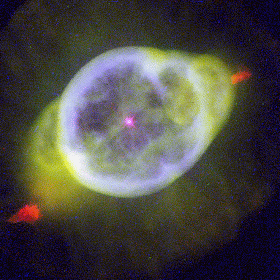Το
Φάντασμα του Δία μέσα από τον φακό του Spitzer. This ghostly image
from NASA's Spitzer Space Telescope shows the disembodied remains of a dying
star, called a planetary nebula. Planetary nebulas are a late stage in a
sun-like star's life, when its outer layers have sloughed off and are lit up by
ultraviolet light from the central star. The Ghost of Jupiter, also known as
NGC 3242, is located roughly 1,400 light-years away in the constellation Hydra.
Spitzer's infrared view shows off the cooler outer halo of the dying star,
colored here in red. Also evident are concentric rings around the object, the
result of material being periodically tossed out in the star's final death
throes. In this image, infrared light at wavelengths of 3.6 microns is rendered
in blue, 4.5 microns in green, and 8.0 microns in red. Image Credit:
NASA/JPL-Caltech/Harvard-Smithsonian CfA
Το
διαστημικό τηλεσκόπιο Spitzer φωτογράφισε το «Φάντασμα του Δία». Πρόκειται για
ένα πλανητικό νεφέλωμα που βρίσκεται σε απόσταση 1,400 ετών φωτός από τη Γη
στον αστερισμό της Ύδρας. Η κωδική ονομασία του νεφελώματος είναι NGC 3242 και
η μελέτη του ίσως αποκαλύψει νέα στοιχεία για τα πλανητικά νεφελώματα.
It's a weed, it's
Jupiter, no it's - actually planetary nebula NGC 3242. After a star like our
Sun completes fusion in its core, it throws off its outer layers it a striking
display called a planetary nebula. NGC 3242 is such a planetary nebula, with
the stellar remnant white dwarf star visible at the center. This nebula is
sometimes called "The Ghost of Jupiter" for its similar appearance to
the familiar planet. NGC 3242 is much farther away however, than the measly 40
light-minutes distance to Jupiter. In fact, by comparing the apparent expansion
rate with the actual rate determined from Doppler studies, astronomers have
estimated the distance to NGC 3242 to be about 1400 light-years away. The red
FLIERs visible near the edges of the nebula remain mysterious. Credit: B.
Balick (U. Washington) et al., WFPC2, HST, NASA
Ένα
πλανητικό νεφέλωμα αποτελείται από ένα επεκτεινόμενο κέλυφος ιονισμένου αερίου
που αποβάλλεται από άστρα τα οποία βρίσκονται στα τελευταία στάδια της ζωής
τους.
This trio of ghostly
images from NASA’s Spitzer Space Telescope shows the disembodied remains of
dying stars called planetary nebulas. In the spirit of Halloween, scientists
are releasing a trio of stellar ghosts caught in infrared light by NASA’s
Spitzer Space Telescope. All three spooky structures, called planetary nebulas,
are in fact material ejected from dying stars. As death beckoned, the stars’
wispy bits and pieces were blown into outer space. Image Credit:
NASA/JPL-Caltech/Harvard-Smithsonian CfA
Οι
ειδικοί εκτιμούν ότι τα πλανητικά νεφελώματα μπορεί να παίζουν σημαντικό ρόλο
στη χημική εξέλιξη ενός γαλαξία.



Δεν υπάρχουν σχόλια:
Δημοσίευση σχολίου